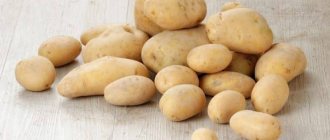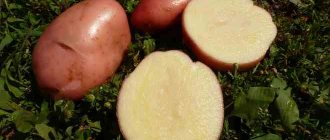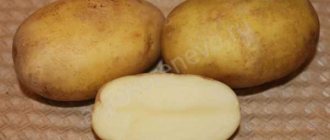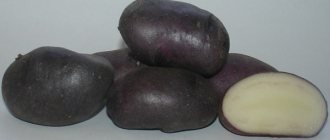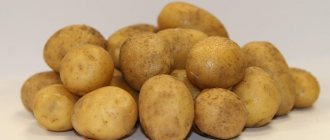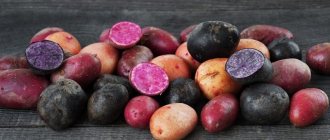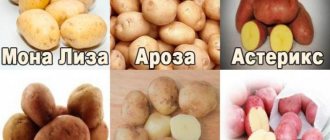Potato Grouse
Terms of payment for goods in the Dobrodar online store Goods purchased in our online store can be paid for in a convenient way from the following:
- At the time of placing an order using the online payment system - non-cash payment.
- At the time of receipt of the goods at the office of the Transport company that was selected for delivery - payment in cash.
- Prepayment to a bank account according to the details, which are sent to the specified email address.
Potato grouse
It would seem that you don’t need to be an agronomist to grow potatoes. Moreover, this stocky, unpretentious plant is very responsive to care and labor. However, a lot of work is still required. And in order not to be disappointed in the results of your personal potato growing, you need to know what to plant. Growing varietal rather than ungraded potatoes is by far the most effective way to get a truly impressive harvest of excellent, tasty potatoes. Today MirSovetov will help readers decide on the choice of a good productive potato variety.
Article on the topic: Potato variety “Newton” - description and photo
Planting and nuances of agricultural technology
Gardeners choose Luck, counting on an early harvest. However, many people make the mistake of planting potatoes in the ground too early. Tubers of the Udacha variety are afraid of frost and if the temperature drops below zero, they stop growing or even die. The optimal planting time is 1–2 decades of May, depending on the climatic characteristics of the region.
Traditionally, the soil for potatoes begins to be prepared in the fall. Weeds are removed from the site, rotted manure and fertilizers are scattered. Before frost, the soil is dug up 2 times. In the fall, before frosts, just a spade and in the spring, when the soil warms up, by 10–15 cm.
Amount of fertilizers per 1 m²:
- rotted manure - 7 kg;
- superphosphate - 35–40 g;
- potassium sulfate - 15–17 g.
In recent years, soil preparation by sowing green manure: mustard, radish, lupine, sweet clover, and legumes has become increasingly popular. Plants are sown after harvesting. In order to grow, the remaining warm days will be enough for green manure plants. A month after germination, the stems grow to 10–15 cm, this is quite enough to fertilize the soil. The plants are cut with a flat cutter or hoe and plowed into the ground to a shallow depth. Decomposed green manure enriches the soil with useful substances and destroys fungal infections.
Related article: Potato variety “Volare” - description and photo
Rotting can be accelerated with the help of preparations with beneficial microorganisms (Baikal M1, Siyanie, etc.). The green mass is treated with a solution of these drugs before being buried in the ground.
Tuber preparation should begin long before the gardening season. Potatoes of medium size, even shape, and without visible damage are left for planting. You need to put aside more seed material than is required for planting, since some of the root crops may not sprout. Before germination, experts advise treating the tubers with preparations for growth and protection against pests, for example, Prestige, Micom, Poteytin.
For sprouting, potatoes are placed in a bright room with a humidity of 70–85% and at a temperature not exceeding 20° C. The seeds are scattered in a single layer in boxes or on the floor. The tubers germinate for 15–20 days, turning them over periodically so that each side receives equal doses of light. Before planting, inspect the potatoes again, remove seedlings that are too thin, and leave thick, strong shoots.
What are the differences between potato varieties?
Different varieties of potatoes differ in the appearance of the tubers and the above-ground parts of the plant. Tubers of different varieties have different shapes, colors and tastes. In addition, varieties are characterized by varying resistance to different diseases. And potatoes have a lot of them - about 30 viral, 10 bacterial and more than 50 fungal diseases can affect potato plants. Varieties exhibit their qualities differently in different types of soil. Each variety has its own optimum growth at a certain temperature and humidity. That’s why it’s important to choose the right variety based on your local conditions.
How to obtain varietal potatoes
To obtain healthy seed material of varietal potatoes, several years of painstaking work are required. The process looks like this: in the first year, potato plants are grown from seeds obtained as a result of breeding work. They are grown in sterile conditions - in test tubes. Sterility is necessary to obtain guaranteed healthy seed material. This is how the primary seed material – mini-tubers – is obtained. In the second year, tubers of the first reproduction are obtained from mini-tubers under field conditions. In the third year of planting, real seed material of the super-super elite category is obtained. The fourth year of reproduction are tubers of the super elite category. In the fifth year, the super-elite plants select the best of the best in all respects. The offspring of these best selected plants of a certain variety are called the potato elite.
Therefore, if you have already decided to purchase new varieties of potatoes, then you need to buy seed material of the elite and super-elite categories.
Characteristics of varieties
All over the world, growing high potato yields is considered a task of national importance. For example, in Ireland, potatoes are the main crop and occupy almost all areas of farmland. Breeding work is developed at a high level in Germany and Holland, and recently the breeding school of Belarus has reached the world level. Each selection school has its own advantages and disadvantages. Western European varieties are distinguished by high yield and marketability of tubers, but Russian, Belarusian and Ukrainian varieties are more flexible and have excellent taste. In general, there are more than 4 thousand varieties of potatoes in the world.
Depending on the needs for which potatoes are grown, there are 4 groups of varieties:
Three groups of potato varieties have been identified, which are characterized by ripening periods: early-ripening, mid-ripening and late-ripening.
Given the unpredictability of weather conditions, it is a good idea to cultivate several varieties with different ripening periods. In addition, having several varieties, you can compare and select those varieties that have shown excellent productivity on your soil and in your region.
Early ripening varieties
Early maturing varieties, as the name suggests, effectively use moisture in early summer. Full ripening of tubers occurs in 60–70 days. Some varieties allow you to dig up tubers already 40 days after emergence. Such, for example, is the Dnepryanka variety of Ukrainian selection or the Impala variety of Dutch selection.
There is an opinion that early potato varieties are suitable only for summer and autumn consumption, since they are not stored for a long time. But this is not true at all. There are many early varieties that are perfectly stored in winter, but require proper storage conditions - a stable temperature of 2-3ºC.
Early potato varieties include:
Related article: Potato variety “Ivory Russet”: description and photo
Description of the Arosa potato variety, cultivation characteristics and yield
The Arosa potato variety, bred by breeders from Germany less than 10 years ago, is grown not only in Europe; it is also popular on other continents. Tubers are used for preparing various dishes, side dishes, and producing chips. Boiled young potatoes, which begin to be dug up a month and a half after germination, are adored by both adults and children. Arosa easily tolerates heat and drought, which allows you to grow potatoes without installing an irrigation system.
Description of the variety
From each bush of a plant that has a beautiful shape, smooth straight stems, and abundant foliage, 15 or more tubers weighing 120 grams are dug out. The yield of Arosa per hectare exceeds 55 tons. Potatoes are different:
- yellow pulp;
- pink skin;
- rough surface covered with eyes.
One root vegetable contains slightly less than 15% starch and contains folic acid, phosphorus, magnesium and calcium. Young potatoes are rich in vitamin C, which restores tissue cells, strengthens bones and teeth, and protects the body from infection.
The description of the variety and its external characteristics attracted farmers and gardeners from different regions of Russia.
Arosa is cultivated both in Western Siberia and in the southern regions, collecting excellent harvests. The potatoes sprout evenly, the branches grow straight, the dense inflorescences have a reddish color.
Root crops fully ripen in 70 days, but they are dug up for cooking, baking, frying, and preparing salads after 45–50.
Gardeners love Arosa potatoes:
- for ease of care;
- resistance to viruses;
- great taste.
Farmers value the variety because the tubers are not damaged during transportation and retain their marketable appearance for a long time. Such a characteristic as keeping quality, which is 94%, is also of great importance for them. The Arosa variety adapts to any soil and tolerates both cold and hot weather.
Growing
Tubers are planted in the ground when it warms up well. Sowing begins in the southern regions, in Siberia and in the middle zone - a week or 2 later. So that the variety does not let down the yield, choose a root crop:
- weighing from 55 to 75 grams;
- with eyes on the surface;
- no dents or scratches.
Shoots will appear earlier if the potatoes left for seeds are sprouted in advance. The best place for a garden bed will be the area where:
- spring and beans;
- mustard and cabbage;
- rapeseed and radish.
The soil is fed with manure, dug up without loosening the lumps; insects that live in the ground will freeze in winter.
When the soil warms up, tubers are planted. To do this, a place for a hole is marked every 30 cm, leaving 70 between the rows. Sprouted potatoes are placed in the holes and covered with soil.
Features of care
To grow a good harvest, it is not enough just to follow the rules of agricultural technology. The ripening period of tubers is affected not only by the weather, but also by how the rules for caring for Arosa potatoes are followed; the description of the variety indicates the need:
- hilling beds;
- feeding with fertilizers;
- weed removal;
- soil moisture.
Despite its resistance to drought and heat, in order to grow large root crops, the beds need to be watered. It is better to do this early in the morning or late in the evening, otherwise there is a risk of sunburn on the foliage. It is necessary to moisten the soil when sprouts emerge to the surface, form buds, and after flowering. Stop watering potatoes during rains and three weeks before digging up the tubers.
The bushes are hilled several times per season, the first when their height reaches 18 or 20 cm. During feeding, the dosage of fertilizers should not be exceeded, as this will deteriorate the taste of the tubers.
At the beginning of the growing season, it is better to use the mineral substances superphosphate and nitroammophosphate. When buds form, potassium salt and ash are added to the root of the plant. The third feeding is optional. Nutrient components are well absorbed if they are added during watering.
Experienced gardeners spray the tops with a solution of Bordeaux mixture twice a season.
Advantages and disadvantages
Arosa potatoes have clear advantages over other varieties of this crop. Root crops are suitable for consumption within a month and a half after planting, have a pleasant taste and high shelf life. Arosa is not affected by many diseases, but requires mandatory treatment for scab and rhizoctonia. An important advantage of the variety is drought resistance.
Article on the topic: Potato variety “Zabava” - description and photo
Pests and diseases
Arosa plantations attract with beautiful bushes and lush foliage of a rich green hue, and dense purple inflorescences.
The variety is not affected by mosaic - striped or wrinkled. Arosa rarely suffers from leaf curl and late blight, dry spotting, and does not get sick:
- fusarium;
- verticillium wilt;
- potato cancer.
The variety is not resistant to rhizocnoniosis, which is caused by pathogenic fungi. The problem is easy to detect in the spring. Not all planted tubers germinate; the sprouts that appear curl. Arosa is susceptible to infection with silver scab. To prevent these diseases, seed material is treated with fungicides or potassium permanganate.
To prevent the development of late blight, gardeners cut off the tops two weeks before digging up root crops.
Mole crickets cause great damage to the crop. Insects, reaching a length of up to 5 cm, dig holes in the ground, destroy sprouts and seeds, and damage tubers. To protect potatoes from this insect, root crops are treated with Prestige or Aktara before planting. They cope with it using insecticides Boverin, Medvedox, Rembek.
Colorado beetles can destroy not only beds, but also entire fields of nightshade crops in a short time. They fight the parasite, which feasts on both tops and leaves, using folk methods and by treating potatoes with chemicals. Not all pest control drugs can destroy Colorado potato beetles, since after a while the toxic substances cease to pose a danger to the insects, and the parasites get used to them.
Systemic agents that contain several active components are most effective in the fight against arthropods. Bushido insecticide instantly paralyzes pests, affecting the nervous and digestive systems. When spraying potatoes with Bankol, Gulliver, Intavir, larvae and adults die.
Harvest and storage
Tubers of the Arosa variety for preparing salads, cooking and frying are dug up already a month and a half after germination. For long-term storage and chip production, the crop is harvested 20 days later.
Root crops are dried and then sent to the basement or cellar. Arosa potatoes have excellent keeping quality and do not lose their taste and presentation until May. Judging by the reviews, this is one of the best early ripening varieties.
Mid- and late-ripening varieties
There are mid-early varieties with a growing season of up to 100 days and mid-season varieties with a growing season of up to 125 days. Tuber formation in these varieties occurs 80–100 days after germination.
Late potato varieties vegetate for 140 days or more. Tubers are formed 110 days after planting.
These varieties have powerful tops and consume large amounts of moisture.
Mid-ripening and late-ripening varieties are characterized by greater accumulation of starch and dry matter, excellent taste and good keeping quality.
- Varieties of Russian selection - Lazar, Yugra, Resurs, Vasily.
- Varieties of Belarusian selection - Skarb, Krinitsa, Zhivitsa, Garant.
- Varieties of Dutch and German selection - Rosalind, Romano, Roko, Ramos.
Late-ripening potato varieties:
- Varieties of Belarusian selection - Zdabytak, Alpinist, Zarnitsa, Suzorie, Vesnyanka.
- Varieties of Dutch and German selection - Rodeo, Mondial, Asterix.
- Varieties of Russian selection - Vityaz, Malinovka, Lorch.
- The variety of Ukrainian selection is Teterev.
Exotic potato varieties
Exotic potato tubers have a non-standard color: blue, red, pink, black and striped. 1 kg of such potatoes is not cheap. The most expensive exotic potatoes cost up to 500 euros per 1 kg. The demand for such potatoes is, of course, limited. These potatoes are used to make unusual chips and are used in extravagant salads.
Exotic potato varieties:
- Shatland Black - has a purple color.
- Highland Burgundy Red – beet color of the pulp.
- Salad Blue - extraordinary blue chips are made from this potato.
- Caribbean is a popular variety in the USA. Purple peel and snow-white flesh. These potatoes make an incredibly fluffy puree.
As you can see, dear readers of MirSovetov, the potatoes we are used to have a wide variety of tastes and varieties. Choose the best one according to your taste.
The Institute of Potato Growing of the UAAN has developed nematode-resistant potato varieties that have already proven themselves.
How to choose a potato variety for planting?
To date, more than one hundred potato varieties have been entered into the Register of Ukraine, a significant part of which are of Ukrainian selection.
Variety "Povin"
Early ripening varieties Povin : yellow, short-oval tubers, yellow flesh. The flowers are red-violet. Poran : pink tubers, white flesh. The flowers are red-violet. Created at the Polesie experimental station.
Variety "Dobrochin"
Mid-early varieties Nemeshaevsky 100 : pink, oval tubers, creamy flesh. The flowers are red-violet. Resistant to potato nematode and relatively resistant to stem nematode. Obriy : tubers are short-oval, white-yellow, white flesh. Dobrochin : oval pink tubers, white flesh. Has good taste.
Variety "Slavyanka"
Liley varieties : tubers are elongated-oval, cream-colored, cream-colored flesh, white flowers. Resistant to potato nematode and relatively resistant to stem nematode. Slavyanka : one of the highest-yielding Ukrainian varieties. The tubers are oblong-oval, pink, with creamy flesh. Relatively resistant to viral diseases.
Variety "Teterev"
Mid-late varieties of Grouse : tubers are round, pink, white flesh. This variety has increased resistance to late blight. Dzvin : pink, oval tubers, creamy flesh. It has a high starch content and good taste.
Attention! The Dobrochin variety can be planted in all regions of Ukraine. All others are suitable for the conditions of Polesie, Forest-steppe and Steppe.
Article on the topic: Potato variety “Otrada” - description and photo
Photo: Mikhail Kutsy.
What varieties of potatoes are chosen in central Russia
It’s good to have potatoes with different ripening periods in your beds. This will allow you to resist some seasonal diseases and pests, and most importantly, you can enjoy young potatoes until the fall. It is worth remembering that depending on the variety, potatoes are stored differently, and varietal characteristics may change.
More than three dozen table varieties with different characteristics (yield, weight of one tuber, starch, keeping quality) have high expert ratings.
Productivity is the total volume of production obtained by growing a particular crop.
Starch (carbohydrate content) is a qualitative characteristic of potatoes, high levels of which indicate a higher density of the tuber pulp and friability during heat treatment. Such potatoes are more aromatic, higher in calories and have a rich taste, more suitable for stewing, baking, mashing (starch more than 20%).
Keeping quality characterizes the ability of a crop to maintain its quality characteristics for a certain time.
https://ru.wikipedia.org/wiki/Potatoes
Early risers in the potato patches
Many summer residents have been familiar with the drought-resistant and productive (500 c/ha) Udacha potatoes for more than 25 years. Some tubers of this variety weigh 250 g (starch - 12%). Up to 4.8 kg of yield is obtained from one plant; potatoes rarely suffer from late blight and produce a good harvest in cool climates.
Gardeners have preferred the early-ripening variety Udacha with giant tubers for more than 20 years
Vineta is a relatively young variety of German selection, which appeared on sale 15 years ago. More than 200 centners are collected from one hectare. The fruits are smooth (up to 100 g), with a light yellow peel and pulp of the same color (starch 15%). The growing season of Vineta is 55–60 days; the harvest is stored for up to 10 months.
Article on the topic: Potato variety “Red Rose” - description and photo
Elite German potatoes Vineta are equally tasty in mashed potatoes and in salads, suitable for making chips
Early ripening Dutch potatoes Impala are distinguished by smooth light tubers (average weight 150 g) and yellowish pulp, crumbling when cooked (starch content 14.6%) . From one adult bush you can get up to 3.5 kg. The variety is not afraid of potato nematode and scab. The first harvest is tried on the 50th day after planting.
Impala potatoes are crumbly and flavorful in side dishes, but are not intended for storage
Red scarlett is an early potato, the yield of which reaches 270 c/ha, with an average weight of one tuber of about 100 g. The starch content of Red scarlett is within 15%. Elongated tubers with bright pink skin and yellowish pulp do not germinate until mid-spring; The variety rarely suffers from fungal diseases of nightshades. The growing season is 45–50 days.
Tubers of the table variety Red Scarlett lie in the vegetable storehouse for up to 10–12 months, while maintaining excellent taste and not rotting in the middle
Zhukovsky early with rich white flesh and pale pink skin is slightly crumbly (starch up to 12%), it is good to prepare salads from it. One potato bush can produce up to 4.5–5 kg of selected tubers, each weighing 90–120 g. The variety stores well, the harvest is ready within 1.5 months after planting.
Early Zhukovsky can safely be classified as a forty-day variety; the first tubers can be dug within 40 days after planting
Description of the variety
Potatoes "Teterev" are one of the best varieties of Ukrainian selection, famous since the times of the Soviet Union. The variety was obtained by breeders at the Polesie Experimental Station named after Zasukhin and was included in the Register of Plant Varieties of Ukraine back in 2002.
The tubers are round and pink. The eyes are small and relatively superficial. Potato pulp is white. The starch content in it is 18.6%. Taste qualities are assessed on a tasting scale at 4.8 points. Yield indicators at the final stage of the growing season reach 520 c/ha.
The characteristics of the variety indicate good keeping quality of the crop and, therefore, the possibility of long-term storage. The variety is resistant to potato nematode and diseases such as cancer, late blight, scab and viral infections.
Agricultural technology
At high temperatures (+30-40°C), especially on light soils, in order to avoid the formation of darkening in the pulp of tubers, it is necessary to form larger ridges, regularly maintain moisture in the soil and add additional doses of Calcium (Ca) to the soil, mainly during planting.
The recommended amount of Nitrogen is normal for an early variety. The variety is responsive to additional application of magnesium and manganese. Characteristics of the variety
- Tuber fraction : 35-55 mm
- Precocity : Early
- Growing season : 70-75 days
- Tuber shape : Elongated oval
- Tuber size : Medium-large/large
- Peel color : Pink
- Flesh color : White
- Type of preparation : Non-crumbly / slightly crumbly
- Keeping quality : Good
- Weight of marketable tuber : 90-130 grams
- Productivity : on the 45th day after full germination - 8.4 t/ha, on the 55th day - 10.8 t/ha. Maximum yield - 27.0 t/ha
- Dry matter content: 18,6%
- Nematode resistance Ro 1.4 : resistant
- Potato cancer : resistant
- Rest period: 6
- Resistance to PVYn virus: 7,5
- Late blight of plants: 4,5
- Late blight of tubers: 7
- Common scab: 5,5
- Drought resistance: 6,5
- Distance between ridges – 75 cm
- 28/35 mm – Distance ± 27 cm
- 35/50 mm – Distance ± 32 cm
- 50/55 mm – Distance ± 38 cm
You can find out more useful information about potatoes and their cultivation from the articles:
Let's talk about the results of the 2021 season . Which varieties turned out to be the most productive and tasty?
I think that since you are here, you are one of those who do not want to waste time on experiments and immediately purchase the best, most delicious varieties of seed potatoes, the most productive and disease-resistant. To plant them this year, 2021.
Potato varieties with photos and descriptions: review
I will try to indicate all the characteristics of the variety by which you can judge this potato and make a conclusion whether to plant it or not. After the article - reviews from gardeners about different varieties of potatoes. Moreover, the reviews are both good and bad.
We took into account the feedback from gardeners from different regions about potato varieties and selected the main, most common varieties with positive feedback at the end of 2021.
Potato Gala, variety description, photo
Early high-yielding potato variety. The tubers are round-oval in shape, yellow in color, the flesh is yellow or dark yellow, the eyes are small. The ripening period is 75-80 days. The weight of each tuber at maturity is 100-140 grams.
Gala potatoes are valued for the high marketability of tubers, resistance to mechanical damage, excellent taste and keeping quality during winter storage. The variety is resistant to potato nematode, cancer, scab, and moderately resistant to late blight of tops.
When growing this variety, it is recommended to mow the tops 10-12 days before harvesting.
Potato Impala, characteristics of seed potatoes
An early high-yielding variety of white potatoes. Its bush is tall, up to 75 cm, forms 4-5 stems, flowers are white. Impala potato tubers are yellow, oval-shaped, the eyes are small, the skin is smooth, the flesh is light yellow.
The variety is resistant to cancer, potato nematode, susceptible to late blight and rhizoctonia, and is weakly affected by viral diseases and common scab. The period from germination to technical ripeness is 70-75 days.
Impala potatoes are valued for their early ripening, high productivity, marketability and excellent taste of tubers.
Red Scarlet potatoes, photos, reviews
This is an early, very productive potato of Dutch selection. It surpasses many well-known varieties in terms of productivity.
The bush is about 70 cm high, forms 7-8 stems, the flowers are red-violet. The tubers are elongated-oval with a smooth red skin, yellow flesh and small eyes. There are usually 20 or more tubers in a nest, each weighing 80-85 grams.
The Scarlet potato variety is resistant to late blight, cancer, and leaf curl. It tolerates drought well, making it suitable for growing in very hot climates. The ripening period is about 75 days.
When cooked, potatoes of this variety do not fall apart, maintaining the appearance of tubers. It does not darken during cutting, which is typical for many other varieties. Tubers store well in winter.
The Scarlet variety is resistant to the most well-known viral diseases, but weakly resistant to common scab. The variety is sensitive to late blight of tops, but at the same time resistant to late blight of tubers, which is more important.
Advantages of the variety
Potatoes of the "Teterev" variety have the following advantages:
- the opportunity to get a good harvest already at the first digging one and a half months after planting;
- excellent taste of potato pulp;
- high resistance to major potato diseases;
- highly marketable appearance of tubers;
- excellent keeping quality and transportability of the crop.
This mid-late potato variety is characterized by high yield.
High-yielding varieties
Many high-yielding potato varietal lines make it possible to grow a large and good harvest even in unfavorable regional Siberian conditions.
Early ripening potatoes Alena are loved by Siberian gardeners for their high yield, reaching 300 kg per 1 sq. m of sown area. The tubers, which ripen on average in 2-2.5 months, weigh 100-100 g, have an oval shape, pink skin and white flesh.
Related article: Potato varieties for the Central Black Earth region: list
These productive potatoes have good shelf life, reaching 95%, and retain a pleasant appearance during transportation.
Resistant to scab and potato cancer, Alena is often exposed to late blight. It is suitable for cultivation throughout the Siberian region, as it is frost-resistant.
Showing a yield of about 300 kg per hundred square meters, the early-ripening table potato variety Antonina is able to resist late blight and powdery mildew.
The vegetable is distinguished by a yellow, slightly rough peel and dark yellow flesh. Gardeners note good shelf life: the harvest is preserved in 95% of cases.
Most often, Antonina can be seen in summer cottages in the western part of Siberia.
A universal variety that has proven itself among gardeners due to its increased yield. Some summer residents collect 350-360 kg per square meter. m of sown area. Potato tubers with white flesh weigh on average 110-130 g, and there are up to 15 vegetables in the nest. This variety is suitable for western and eastern Siberia.
Ermak is included in the list of the best potato varieties in Siberia in terms of yield, producing up to 500 kg with an average weight of potato tubers of 100 g. A potato nest has up to 25 root crops. Round-shaped vegetables with pink smooth skin and light flesh.
Ermak is recommended for cultivation in any Siberian region.
Growing technology
The area for planting potatoes should be level and well lit throughout the day. In the fall, 5-10 kg of humus per square meter should be added to the beds intended for potatoes, and it is also necessary to carry out deep plowing and remove all plant debris from the site. When planting potatoes, it is recommended to add humus and wood ash.
Watering is best done from the budding stage to the ripening of the crop. Irrigation measures can be supplemented with fertilizing, taking into account the fact that the potato variety “Teterev” has an increased need for nutrients, especially potassium.
Top dressing can be both foliar and root. Ammonium nitrate is used as a fertilizer when carrying out foliar feeding, namely spraying. You can also add macro- and microelements using the foliar method. Potatoes are also fed with organic matter: liquid bird droppings or slurry.
It is very important to carry out regular weeding of plantings, as well as surface loosening of the soil between rows and hilling, which is necessary to increase productivity and protect tubers from adverse weather conditions. To protect against diseases and pests, preventive spraying of tops with folk remedies or systemic chemicals is carried out.
Potato Lad
A variety of Belarusian selection, high-yielding, mid-season, unpretentious to care and any growing conditions. The tubers are large (from 90 to 150 g) and store well. The harvest from one bush is 10-14 pieces. The peel is yellow, resistant to mechanical damage. The pulp is light yellow with a high starch content and good taste. When cooking it boils medium. Suitable for any dishes, as well as chips and processing into dry potatoes. The variety is resistant to major potato diseases.
For all varieties of potatoes, the price is PER SET, consisting of TEN mini-tubers of the same variety. Mini-tubers are not sent individually.
This product is mailed out in the SPRING.
Potatoes are one of the most favorite crops of Russian gardeners. But in order to get a good harvest of full-fledged tubers, it is necessary to very clearly fulfill all the requirements of its agricultural technology.
Choosing a location.
Potatoes should be planted in an open, well-lit place. Even light shading can significantly reduce yield. The culture does not tolerate heavy, acidic soils and close groundwater (their level should be no closer than 1.5 m from the surface of the earth). Loamy and sandy loam soils with a neutral or slightly acidic reaction (pH 6-7), rich in organic matter, are best suited for potatoes.
Planting material.
They begin to prepare it 2-3 weeks before planting.
To make the tubers germinate faster, they are germinated in a bright, warm room at a temperature of 16-18 degrees. The tubers are carefully scattered onto some underlying material (newspapers, used white non-woven covering material such as lutrasil
or
spunbond
). Do not spray or water under any circumstances! Before planting, potato sprouts must be at least 1 cm long.
Article on the topic: Potato variety “Mars” - description and photo
Soil preparation.
The soil for planting tubers begins to be prepared in the fall. On the acidic side, neutralization is carried out with the simultaneous application of fertilizers. Dolomite flour or chalk is used as a deoxidizer (in no case is slaked lime, as it will accumulate in the tubers and then enter your body, which can lead to serious illnesses). At the same time, the following are added for digging (per 1 sq.m.): 6 buckets of rotted manure or compost, 3 buckets of sand (on clay), 4 matchboxes of superphosphate, 3 boxes of potassium sulfate and a third of a bucket of wood ash. The area is carefully dug up using 1.5 shovels. A week after digging, the future potato field can be sown with white mustard, which is mowed at the end of November before the snow falls. It will additionally enrich the soil with nutrients and repel dangerous pests such as wireworms and beetles.
On slightly acidic and neutral sandy and loamy soils, spring digging with the application of the above doses of fertilizers is sufficient. There is no need to add sand to them. In sandy areas, potatoes are also prepared in the spring. But there, instead of 6, they add 8 buckets of organic matter per 1 sq.m.
Crop rotation.
In amateur gardening, it is recommended to grow potatoes in one place for no more than three years (in industrial crop rotation, field maps are changed annually). By correctly alternating crops before and after potatoes, you can significantly reduce the infestation of land with pests and diseases. Each gardener decides for himself what crops to plant. It is not at all necessary to strictly follow any scheme. It is enough to remember that the best predecessors for potatoes are: squash, zucchini, pumpkin, cucumber, legumes, carrots, beets, herbs, spices, onions, white and cauliflower, garlic, corn. But you can’t plant potatoes after tomatoes and peppers. And immediately after it, planting strawberries, tomatoes and peppers is not recommended.
Landing
. Gardeners use several methods of planting potatoes, primarily depending on the topography and soil composition. For each, pre-planting (spring) soil preparation and fertilizer application doses are different.
Under the shovel.
This is the most common method. It is best used on flat areas. In spring, do not dig the soil deeply: this way it will retain moisture longer after the snow melts. It is loosened shallowly with a cultivator or pitchfork, and then leveled with a rake.
Potatoes are planted in early May “along a cord” stretched on pegs. At a distance of 30-35 cm, dig holes 6-8 cm deep and place the tubers there with the sprouts facing up. Add 2 handfuls of compost (or rotted manure) and 1 tbsp to each hole. spoon of wood ash. Then the tuber is sprinkled with soil from each subsequent hole. The distance between rows is 75-80 cm.
After the potatoes sprout, they are earthed up twice - a week after emergence and before flowering begins. Water depending on the weather, but not more than once a week. After each hilling, the plants are fed with natural organic matter (for example, slurry in a ratio of 1:10).
Into the ridges.
Thus, potatoes are planted on waterlogged heavy soils or where groundwater is close. In spring, ridges 15-20 cm high are formed in the potato field. The easiest way to do this work is with a walk-behind tractor. The distance between the ridges is 70-75 cm. The tubers are planted in holes located on the tops of the ridges at a distance of 30 cm from each other.
Subsequently, the potatoes are cared for in the same way as in the previous case. Only watering is carried out more often, since the soil on the surface of the ridges dries out faster. In order to retain moisture in them longer and prevent the formation of a soil crust, the ridges are mulched with straw or freshly cut grass.
In the trenches.
In this way, potatoes are planted on sandy soils. On such soils in the fall, after digging and applying fertilizer, trenches are dug 30-35 cm deep at a distance of 80-90 cm from each other. A thick (15 cm) layer of raw hay is placed in the trenches, and fresh manure (5-6 cm layer) and wood ash (1 bucket per 1 running meter of trench) are placed on it. Over the winter, the hay and manure will rot and become compacted. In spring, tubers are placed in trenches two weeks earlier than with other methods. The top of the planting is covered with non-woven covering material (agrospan). Before flowering, potato bushes are hilled 3 times, raking the soil towards the plants. If the trenches are not prepared in the fall, they can be dug in the spring, but in this case, already rotted manure is placed in them.
Dutch method.
In this case, potatoes are planted in high beds at a distance of 40–45 cm from each other. The distance between the ridges is 70-80 cm. Along with the tubers, in addition to compost and wood ash, add a pinch of superphosphate and potassium sulfate to the hole. Much attention is paid to loosening the soil, watering, and fertilizing (slurry and fermented grass are fed 4 times during the growing season). The earth for hilling is taken from the inter-row spaces, so the roots of the plants are not damaged. The tops are mowed two weeks before harvest.
Growing in straw.
This is an old method that is more than 100 years old. The area prepared in the fall is covered with a thick layer of hay or straw. In spring, potatoes are planted in rows directly into rotted grass and again covered with straw or hay. The distance between tubers is 30-35, between rows - 70-80 cm. Instead of hilling, a layer of hay is poured around the bushes.
Article on the topic: Potato variety “Musinsky” - description and photo
With this method, there is no need for fertilizing and weeding. Plus it's much easier to clean up. And the potatoes turn out clean and are not injured by a shovel, since they can be removed manually.
Watering.
Potatoes require a lot of moisture to form a good harvest. With a lack of water, the stems become deformed, the lower leaves dry out, and the tubers stop growing.
Therefore, it needs to be watered regularly, especially on sandy soils. On clay soils, water should not stagnate, otherwise the tubers may rot.
After watering, the plantings are mulched with straw, hay or sawdust. This allows you to protect the soil from drying out, prevents the growth of weeds and creates optimal conditions for the development of soil microflora.
Pests and diseases.
The most common pests on potatoes are: Colorado potato beetle, wireworm, leafhoppers, potato flea beetle, potato moth, potato cutworm, aphid and various nematodes.
The most dangerous of them is the Colorado potato beetle. They pose the main threat to potato fields in many regions of the country. If, when this pest appears, it is not combated, then its adults and larvae can completely destroy all the castings and young potato stems.
To combat the Colorado potato beetle and other potato pests in Rus', from time immemorial, intercroppings of black Russian beans between potato rows have been used. For mild damage, biologically active drugs are used: “Boverin”, “Fitoverm” and “Agrovertin”. Their most active action occurs on the 5-7th day. In case of more severe damage, they resort to stronger chemicals: “Commander”, “Iskra”, “Mospilan”, “Aktara”.
But chemistry should be resorted to in the most extreme cases. It is better to start with protective measures: using healthy planting material and soil, destroying insect eggs, collecting larvae and adults, spraying plants with decoctions of celandine, tansy, basil and other plants.
Potatoes are most often affected by diseases such as late blight, scab, various rots, black leg, Alternaria blight, and Phoma.
To prevent the occurrence of bacterial diseases, tubers are treated with preparations such as “Maxim” or “Prestige” before planting. To prevent fungal diseases, week-old seedlings are treated with a 1% solution of Bordeaux mixture. The same treatment is repeated before flowering begins.
When using chemical pest and disease control agents, you must remember that 3 weeks before digging, their use is strictly prohibited.
Cleaning.
Dig up potatoes before the first frost in dry and warm weather. In this case, the ripening times of different varieties are taken into account. Extra early ones are ready 50-65 days after planting. They are used as food during the summer. They are not suitable for storage. Early varieties ripen in 70-90 days. They are also suitable for quick consumption in August-September. Mid-season varieties produce a full harvest in 100-125 days. They are dug up at the end of August. And finally, late varieties are ready in 135-145 days. These are the ones that are put into winter storage. And they clean it up in mid-September.
About a week before harvesting, the tops are mowed: this stimulates the flow of nutrients to the root crops and extends the shelf life.
Before storing for winter storage, the potatoes should finally “ripen”, and the “abrasions” from the shovel should heal. Therefore, agronomists advise waiting a couple of weeks from harvesting to storage. Seed potatoes are laid out under a canopy not in direct sunlight for 2-3 weeks. During this period, the tubers begin to produce a protective substance called corned beef, which turns the potatoes greenish. This agricultural practice is called landscaping. It promotes better storage of potatoes, prevents damage by various diseases and pests, and increases germination and productivity. Edible potatoes cannot be grown green, as they are bitter and tasteless.
Edible potatoes are stored 10-14 days after harvesting, seed potatoes - after the completion of the gardening process.
Reviews about the variety
According to the observations of gardeners, potatoes of the "Teterev" variety form fairly even and neat tubers, the number of which in each nest, as a rule, does not exceed 7-8 pieces. The tubers are quite large in size. The variety shows high yield on heavy and poor soils, which is its undeniable advantage.
Potato pulp is of medium boilability, so it is perfect for preparing not only hot dishes, but also a variety of salads, which makes the variety popular among consumers.
Sources:
https://www.dobrodar.com.ua/catalog/semennoy-kartofel-936/kartofel-teterev.html https://seattlehelpers.org/kartofel/kartofel-teterev.html https://dachadecor.ru/discussions/ potato-sorta-teterev
